How to Protect Your Camera While Traveling – Simple Steps for Every Trip
Published: 03/10/2025
My camera is like my best friend when I travel. It captures the small moments and the big scenes I never want to forget. Cameras are breakable and can be expensive. One small mistake can cause scratches, a broken lens, or even losing the whole camera. I do not want that, and I am sure you do not either. If you have ever wondered how to protect your camera while traveling, this guide will help you.
I will share everything I use to keep my camera safe when I travel. These are steps I follow on every trip. Whether you use a DSLR, a mirrorless camera, or a point-and-shoot, the tips here will help you protect your gear from damage, theft, and bad weather.
So, let’s start our guide.
Why Protect Your Camera While Traveling?
The first question is, why do we need to protect our camera while traveling?
The answer is simple: because cameras are sensitive, and once damaged or stolen, you can lose not only money but also your travel memories.
When we are on a trip, many things can happen that may harm the camera. The weather can change in minutes. One moment it is sunny, and the next moment it may rain. Cameras are not strong against water, dust, or rough handling.
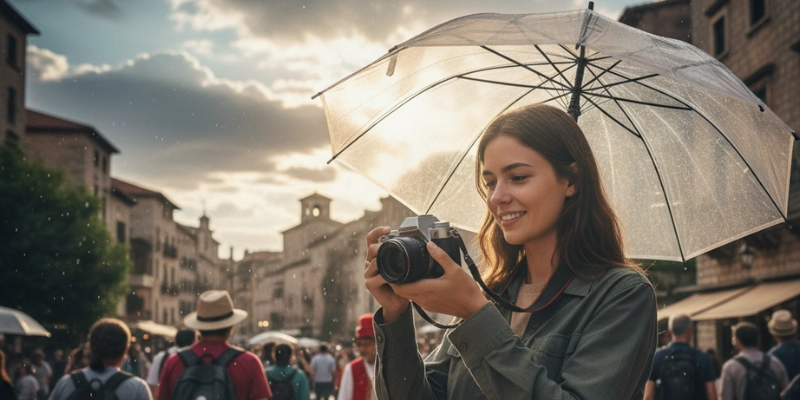
If your camera breaks during a trip, you don’t only lose money. You also lose the photos and videos you worked hard to take. For most travelers, those memories are more valuable than the camera itself.
There is also the risk of theft. In crowded tourist places, thieves often look for expensive items like cameras. If you are not careful, someone can grab it in seconds.
This is why keeping your camera safe is so important. When you protect your camera, you are also protecting your travel memories.
How to Protect Your Camera – Simple Steps That Work
Now that we know why protecting a camera matters, let’s talk about how to actually keep it safe while traveling. I use some simple steps that anyone can follow. These tips cover everything, from the bag you carry to the habits you build on the road.
Here are the main ways to protect your camera during travel:
1. Choose the Right Camera Bag
The first step in protecting your camera starts with the bag. A normal backpack is not enough. I always suggest using a padded, waterproof camera bag. This protects your camera from shocks if you drop it, and from rain if the weather changes suddenly.
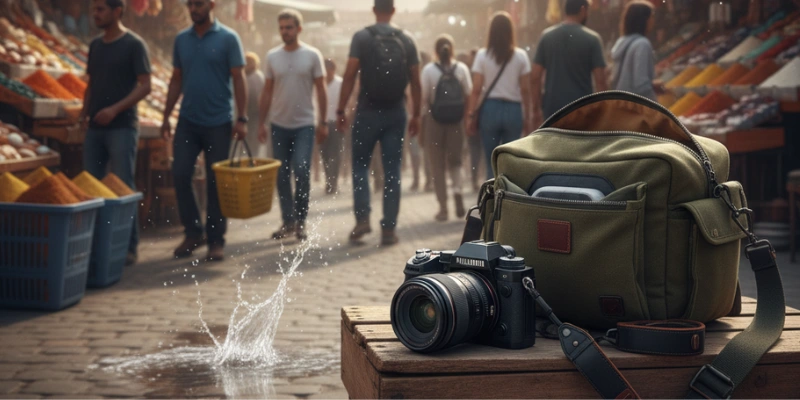
Anti-theft bags are even better. Some bags come with hidden zippers and strong straps, making it hard for pickpockets.
A crossbody camera sling is easier to keep in front of you in crowded places. Some travelers even carry their backpack on their chest when walking through packed trains or markets.
If you want to blend in, avoid bags with big camera brand logos like “Canon” or “Nikon.” A plain-looking bag is less attractive to thieves. You can even cover the camera’s brand logo with tape so it doesn’t stand out.
Tip: I personally like to keep my bag simple and not too big, so I don’t feel tired carrying it all day.
2. Protect Your Camera From Weather
The weather can be a big enemy for cameras. Rain, humidity, and extreme cold all affect your gear.
I always keep a rain cover in my bag. It is light, cheap, and can save your camera from water damage. A dry bag lined with a soft towel also works well in heavy rain or dusty areas.
In hot and humid places, I use silica gel packets inside my bag. They absorb extra moisture and stop fungus from growing on the lens.
If you are traveling in cold areas, remember that batteries drain faster in low temperatures. Keep them in your pocket to stay warm until you need them.
3. Protect the Lens and Screen
The lens is the heart of your camera, and the screen is your guide. Both need strong protection.
A UV filter on the lens works like a shield. Even if it gets scratched, your main lens stays safe.
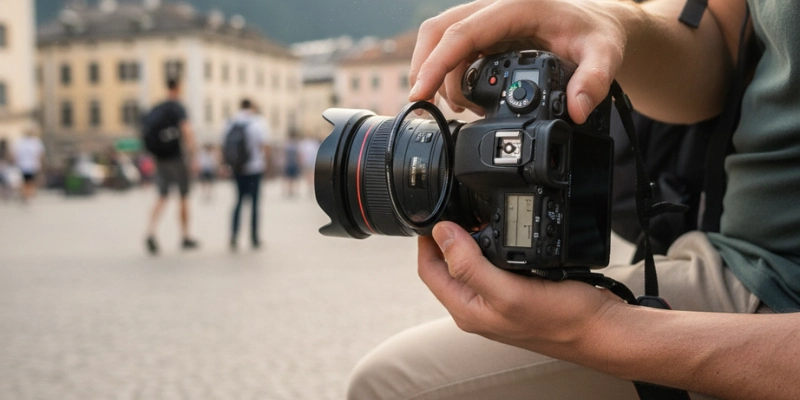
Always put the lens cap back after shooting. I know it feels tiring sometimes, but it’s better than cleaning dust and scratches later.
A simple screen protector can save your LCD from cracks and fingerprints.
These small accessories cost very little compared to repairing a camera.
4. Be Smart Against Theft
Sadly, theft is a real risk in many travel spots. I have seen travelers lose their cameras in crowded streets because they didn’t take basic steps.
Here’s what works for me:
- Never hang your camera loosely around your neck. Instead, use a crossbody strap or wrist strap. A discreet strap without brand names makes you less of a target.
- Don’t leave your bag behind in cafes or hotel lobbies. Always keep it with you.
- In busy areas, avoid pulling out your most expensive gear unless you really need it. Sometimes, a small camera or even your phone is safer.
- Hold your camera tight when doors open on buses or trains, since thieves may try to grab it quickly.
- Some travelers even hide a small tracking tag (like an AirTag) in their bag. If it gets stolen, at least you can track where it went.
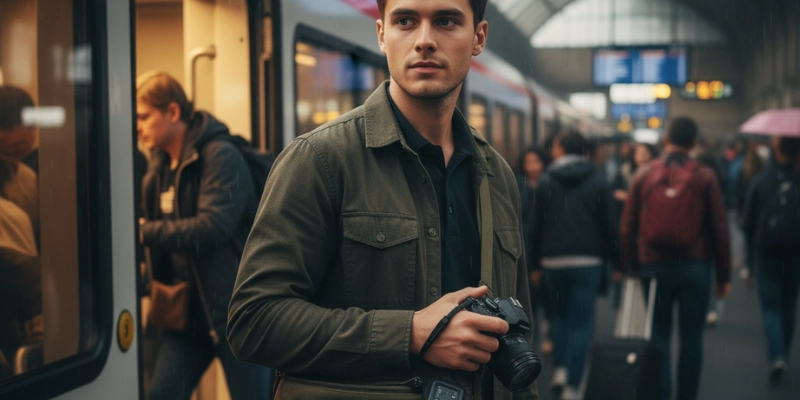
5. Pack Smart When Flying
Airports are stressful places, and camera gear can easily get damaged in the wrong bag.
- Never put your camera in checked luggage. Bags get thrown around, and security checks are not gentle.
- Always carry your camera in your hand luggage.
- If you have multiple lenses, wrap them in soft clothes or pouches to avoid scratches. Even bubble wrap can help if you don’t have enough padding.
- Keep batteries in a small case, since airlines don’t allow loose batteries in checked luggage.
- If possible, keep your camera bag under the seat in front of you instead of in the overhead bin. This way, it stays closer and safer.
6. Use Insurance and Backups
I know many people skip this step, but trust me, it can save you from a big loss.
Travel insurance for cameras covers damage, loss, or theft. If you are traveling with expensive gear, this is worth it.
I also suggest keeping photo backups every day. You can use a small hard drive, a laptop, or even cloud storage. If your camera or memory card gets lost, at least your photos are safe.
Before a trip, I also make a gear list with the serial numbers of my camera and lenses. If anything happens, it is easier to report and claim insurance.
7. Clean and Maintain Your Camera
Traveling means dust, sand, and fingerprints on your gear. Keeping your camera clean is simple if you carry a small cleaning kit.
- A microfiber cloth for wiping the lens and screen.
- A blower to remove dust without touching the glass.
- Lens wipes for quick cleaning.
One mistake I see people make is cleaning the lens with their T-shirt. Don’t do it. The fabric can scratch the glass. Always use proper tools.
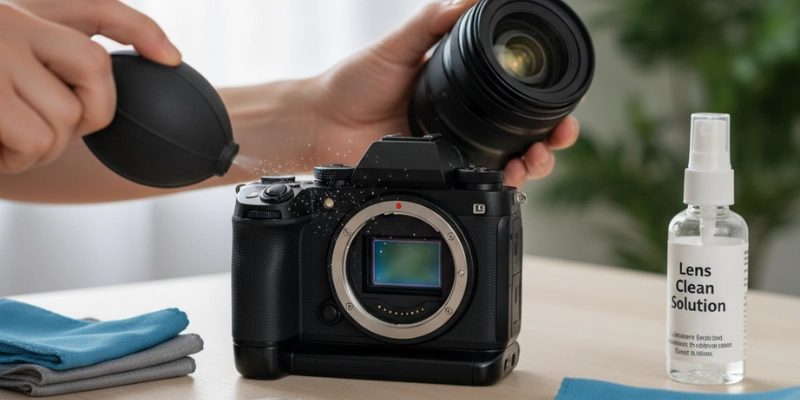
8. Safe Habits During Travel
Even with all the gear, your habits matter the most.
- Never leave your camera alone on a table in a café, even if you are just going to the washroom.
- In hotels, use the safe for extra lenses and memory cards. If the safe is too small, hide your gear in a locked suitcase.
- When walking around new cities, I always carry only what I need. If I don’t plan to use two lenses, I leave the extra ones in the hotel.
- On public transport, keep physical contact with your bag at all times.
These small habits reduce risk and make travel stress-free.
| Quick Safety Checklist |
|---|
|
Here’s a short list you can save before your trip:
|
Final Words
When we travel, a camera is more than just a tool. It saves our memories, our happy moments, and the beauty we see. If it gets damaged or stolen, we don’t just lose money, we lose those moments forever. That’s why knowing how to protect your camera while traveling matters so much.
By using a safe bag, keeping it away from water and dust, and staying alert in crowded places, you can keep your camera safe. I always follow these steps, and they help me enjoy my trips without worry.
Before your next trip, be sure to protect your camera. When your camera is safe, your memories are safe too.
FAQs
No. Always keep your camera in your hand luggage. Checked bags are handled roughly, which can cause damage.
Use a rain cover, dry bag, or a towel inside your camera bag to shield it from water and dust.
Yes, a padded and waterproof camera bag keeps your gear safe from shocks, rain, and bumps better than a regular backpack.
Always use a lens cap and a UV filter. A screen protector can prevent scratches and fingerprints on your LCD.
Keep spare batteries warm in your pocket in cold weather and use silica gel packets in humid or hot places to prevent moisture and fungus.
Clean it regularly with a microfiber cloth, blower, and lens wipes. Avoid using shirts or rough fabrics that can scratch the lens.
Yes. Use crossbody or wrist straps, keep the camera close to your body, and avoid obvious brand logos on bags or straps.
Only take what you need. Extra lenses or gear can weigh you down and increase risk. Leave unused items safely in your hotel safe.
Yes, especially if your camera is expensive. Insurance can cover damage, theft, or loss during your trip.

- Be Respectful
- Stay Relevant
- Stay Positive
- True Feedback
- Encourage Discussion
- Avoid Spamming
- No Fake News
- Don't Copy-Paste
- No Personal Attacks

- Be Respectful
- Stay Relevant
- Stay Positive
- True Feedback
- Encourage Discussion
- Avoid Spamming
- No Fake News
- Don't Copy-Paste
- No Personal Attacks


